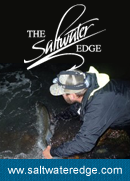I have blog posts from Dennis Zambrotta, Dave Anderson and Crazy Al lined up for you guys, in addition to continuing series from Charles Witek
Under the snow there really will be a spring run. Get ready and celebrate it at Striper Surf Day. It’s a great day to hang out, take in a seminar and tell some lies with fellow surf rats. We’ll have great speakers and an emphasis on how to demonstrations, factory reps, sales, door prizes, gourmet road kill and good friends.
Steve will also be demonstrating how to load Redfins and Northbar Bottle Darters.
Northbar Tackle and more.
In a lot of ways, we consider anything Charles Witek has to say on fisheries management and conservation a “must read”. Charlie has recently started a blog at http://oneanglersvoyage.blogspot.com/
I hope many of you check it out and subscribe to be notified when Charlie posts his thoughts on this very difficult and often confusing subject. But in case you are too lazy to click it we will repost his blog right here. But I do urge you to subscribe to his feed on his blog
I’ve had the good fortune to fish along most of the American coast, from the cod and pollock ledges off New England to the Gulf Stream off Florida, from the reefs of the Keys to the snapper banks of the Gulf of Mexico. I’ve chased fish of various kinds from southern California up to the Columbia River and to Alaska’s Cook Inlet and Prince William Sound. I’ve even done some fishing in Hawaii.
No two places I’ve fished are exactly the same. The fish are different, the water is different, the bottom is different; even anglers’ attitudes and the ways they prefer to fish change as one travels along the coast.
But the really big dividing line is the one that separates warm, subtropical seas from the cooler waters farther north.
Southern seas are filled with a plethora of life. When I fish for snapper down in the Keys, I’m always amazed at the variety of fish that I see over the course of a day. My first fish might be a yellowtail; on the next drift, a cero mackerel hits the bait on its way to the bottom. There will be mutton snapper and margates, gray snapper and grunts, and in the midst of it all maybe a bright blue parrotfish or a spotted, snapping, sinuous moray eel.
My friend Mike Mucha describes a trip on a Keys headboat as “going out for aquarium fish” because of the variety and varied appearance of everything that comes on board.
And that’s not unexpected, because southern waters are known for high biodiversity. They hold a lot of different kinds of fish.
But what a lot of folks—anglers and non-anglers alike—don’t realize is that despite such high biodiversity, southern waters support a relatively low biomass. When you take all of the fish and combine them together, there aren’t nearly as many fish as there are up north.
That’s because southern waters are pretty infertile; they can’t support too much life. The crystal clear water that lets you see a hooked fish flashing when it’s still sixty feet down holds very little plankton, the tiny plants and animals that form the foundation of the marine food web.
For abundance, you need to go much farther north, to the soupy green seas off New England, where a rich broth of single-celled plants and the animals that feed on them can nourish a truly huge, if less complex, web of life.
It is no mystery why whales feed in high latitudes, for that is where the food is.
Bait can seem abundant in southern waters; there are halfbeaks and saury and flying fish, and at the right time of year, big schools of mullet migrate along the coast. But there is nothing in those southern seas that can equal the huge shoals of herring and mackerel that the northern ocean can readily support; nothing ever recorded in the south could equal the immense abundance of the cod, haddock and other groundfish that swam off New England, fish abundant enough to feed much of the Western world for more than four hundred years. And even those once-abundant stocks would probably take a back seat to the hordes of pollock that swim off Alaska.
Northern waters don’t hold many different kinds of fish—the biodiversity is fairly low—but it can support a huge abundance of them. Biomass was once amazingly high.
Down south, there isn’t a lot of any one species (although if you hit the yellowtail right, and see the huge mass of fish that changes the very color of the water as it rises up in response to your chum, you might have trouble believing that’s true). Thus, it is very easy to overfish.
In the north, there aren’t many species, and the very vastness of the stocks made it impossible for anglers—and early fisheries scientists—to believe that they could be harmed by the hand of man. But that abundance concealed more complex stock structures than anyone suspected, and the very abundance might, in itself, have created a vulnerability—perhaps similar to that of the extinct passenger pigeon—in which high numbers are needed for successful reproduction. Whatever the cause, we discovered that northern stocks could be overfished, too.
Federal fisheries law, in the form of the Magnuson-Stevens Fishery Conservation and Management Act, must prevent overfishing, and rebuild overfished stocks, in all of America’s waters.
Thus, one would expect the Theodore Roosevelt Conservation Partnership’s report “A Vision for Managing America’s Saltwater Recreational Fisheries” (
http://www.trcp.org/assets/pdf/Visioning-Report-fnl-web.pdf), which proposes changes to that law, to be as relevant to fisheries off Oregon, Maine and Alaska as it is to fisheries off Alabama or Texas.
Unfortunately, that isn’t the case.
The “Vision” report is very much a response to southern fisheries issues, that gives little consideration to anglers on the West Coast or those who fish north of the Georgia-Florida line (OK, maybe if I was being charitable, north of the Pee Dee River, which divides the Carolinas).
The first, largely superficial hint of that comes from the graphics that accompany the document. Out of the twenty or so photos that grace the inside, you don’t see a single fish or a single photo that doesn’t represent the Gulf of Mexico. There are snook, but no striped bass or salmon. Snappers and red drum, but no cod, fluke or halibut. Mullet, but no menhaden or mackerel.
As you begin to read the text of the document, you also see the same kind of disconnect with anglers who fish far from the five Gulf states. You see an indictment of the federal fisheries management system, but no acknowledgement of its successes in the Mid-Atlantic, where every species under federal management is either fully recovered or well on the way back, and none are overfished or subject to overfishing.
The “Vision” report, in its effort to promote state, rather than federal, management of important recreational species notes that
“Many state natural resource agencies,especially those in the South, recognize the benefits of a vibrant recreational fishing community and have managed to promote it while conserving their saltwater resources. Striped bass, red drum, black drum, summer flounder, sheepshead, snook, spotted seatrout and tarpon are examples of successfully managed state fisheries that sufficiently meet the needs of recreational anglers while providing extensive economic benefits to their state and the national economies.
“Many coastal states have adopted management models that are well tuned for their particular saltwater fisheries. These models conserve fishery resources, provide multi-year consistency in regulations and allow for ample public access. However, these approaches have not yet been embraced by the NMFS, which is a significant contributing factor to the current dilemma in saltwater recreational fisheries management.” [emphasis added]
Even if we ignore the fact that part of that statement is blatantly wrong—summer flounder were the species which set the legal standards for federal fisheries management, and a significant majority of striped bass fishermen would take issue with the stock being “successfully managed,” given that it poised to descend into “overfished” territory within the next year or so—the words “especially those in the South” should be creating a very big red flag for any angler who fishes Mid-Atlantic, New England or Pacific shores.
Because when it comes to problems facing anglers there, the “Vision” report just doesn’t get it.
While the “Vision” report rhapsodizes over “state natural resource agencies, especially in the South” who supposedly “sufficiently meet the needs of recreational anglers,” it ignores the multiple failures of what is undoubtedly the biggest coordinated state fishery management effort—the Atlantic States Marine Fisheries Commission—which in the past 20 years has managed to restore only one stock, striped bass, to health (and is now dithering and delaying taking necessary action called for in the recent benchmark stock assessment, as the striped bass stock comes ever closer to returning to “overfished” status—while over the same period overseeing the decline, and in some cases the collapse, of stocks that include weakfish, Gulf of Maine winter flounder, tautog, American eel, American shad, southern New England/Mid-Atlantic winter flounder, northern shrimp, alewives, southern New England lobster and blueback herring, among others.
Because when you don’t raise your eyes above the Florida border, you’re not going to notice such things.
Nor are you likely to notice that up in New England, and even in the Mid-Atlantic, “state natural resource agencies” are pretty close to the commercial fishing sector, as well as the party and charter boat industry, which generally wants the same sort of risk-prone management that the net boats support. Up here, we’ve already seen what “flexible” management—avoiding hard quotas and using weak proxies such as daily trip limits and limiting days at sea—has done to the cod stocks (there aren’t many left), winter flounder (there are almost none left) and minor groundfish such as whiting (there are quite a few left, but you can’t catch them from piers any more; you need to run 75 miles offshore). We don’t need more “flexibility”; we need more hard quotas, before the little we have left is gone.
It might already be too late for winter flounder and local populations of cod. But if your sole focus is on southern reefs, what happens up here is completely blurred. You neither notice nor care.
And it’s not only here. The West Coast isn’t in focus, either, so you probably don’t see anything wrong with giving even greater authority to those “state natural resource managers” in California who have already closed anglers out of once-prime fishing grounds.
When you manage northern—or at least cold-water—fish, you can’t afford to let a stock collapse. Down south, if you lose a single species, you have scores of others to take up the slack. Up north, that single species may be the only thing anglers can fish for. Here on Long Island, we used to start fishing sometime in March; with the winter flounder all but gone, fishing is barely worthwhile until May. There used to be a winter cod fishery; the fish didn’t show up this year, and I’ve been on shore since before Thanksgiving. If anything happened to the fluke, our bays would be nearly empty throughout the summer.
So when you manage our northern fish, you need to manage for abundance. Conservation matters, because if one species goes missing, you may be left with nothing at all. When stocks are restored to abundance, seasons are long, but there aren’t many things that we fish for.
In the south, biodiversity is so great that you can catch a little of everything. But emphasis must be placed on “a little,” because, by northern standards, nothing is really abundant. You can’t afford to kill a lot of any one thing. And because no species is truly abundant, bycatch becomes a far more significant issue. One of the books that I keep near at hand when writing about fisheries issues is Fisheries Ecology and Management by Carl Walters and Steven Martell. It is a standard and well-respected text, and its authors note the need to be aware of bycatch down south, saying that
“in multispecies situations such as the reef fisheries off the coast of Florida…the bionomic equilibrium with respect to the targeted fish species may be at efforts high enough to drive some ‘incidental’ or nontarget species toward biological extinction.”
I think we can all agree that extinction is bad, yet if we don’t manage all fish in a multispecies complex, such as the reef fish complexes managed by the South Atlantic and Gulf of Mexico fishery management councils, extinction might can happen just because folks want to catch a particular species—such as red snapper—so badly that they don’t take enough time to consider what harm they’re doing to something else.
In such situations, managers need to keep the seasons short to minimize bycatch of the least abundant species while maximizing, to the extent practical, harvest of those that are most abundant. The ideal example may come from waterfowl management; we are given a 60-day season, during which we are allowed a total of 6 ducks, but can take only one black duck, one pintail, etc. Similarly, a short reef-fish season may provide a relatively liberal overall bag, but just one or two red snapper or other still-rebuilding species. Because of the south’s high biodiversity, anglers can easily switch off to mackerel, dolphin, wahoo or inshore species when the reef fish season is closed.
That probably won’t be too palatable to some of the folks down south, who seem to spend all of their time obsessing about red snapper, and figuring out ways to kill a few more.
And, unfortunately, that’s relevant to TRCP’s “Vision”.
Like many groundfish, red snapper have been hit hard over the years by both recreational and commercial anglers. Stocks were overfished, and managers were compelled to adopt strict rebuilding measures. The fish responded.
Anglers are seeing more fish, are catching more fish, and are killing more and larger fish, but the red snapper stock is far from rebuilt. Anglers don’t understand what it will take to fully recover the stock, and they don’t understand why, if the population is growing, they can’t take more snapper home.
So organizations which represent anglers and the fishing industry have spent the past few years trying to find ways to kill more fish.
They found a few friendly scientists who were willing to argue that there were more snapper around than the managers believed; most scientists disagreed, so that didn’t work.
They found a few friendly Congressmen who drafted the Fishery Conservation Transition Act and, later, the Fisheries Science Improvement Act, both of which would delay stock rebuilding, and allow a bigger kill, while more research was done. Neither bill passed, so that didn’t work.
They found a few more friendly Congressmen who drafted the Gulf of Mexico Red Snapper Conservation Act, which would render federal fisheries law irrelevant by handing red snapper management to the states. That bill is still alive, but unlikely to pass, so that probably won’t work, either.
But the reauthorization of the Magnuson Act offers another possibility. The same folks who supported the Gulf of Mexico Red Snapper Conservation Act and other failed attempts to evade the conservation provisions of federal fisheries law (
http://www.coastalconservation.us/images/db_newsfiles/45.pdf) are for the most part the same folks who “contributed” to TRCP’s “Vision” report. And so the same themes—delayed rebuilding, turning management over to the states—that showed up in the failed legislation is now showing up as their “Vision” for the Magnuson reauthorization.
They would make the Magnuson-Stevens Fisheries Conservation and Management Act the “Frustrating Conservation and Rebuilding So We Can Kill More Act.” They’re going to get a bigger red snapper harvest if it’s the very last thing that they do. And if they have to trash the fisheries up north and in the Pacific to do it, they don’t really care.
There’s a saying in presidential politics, “As Ohio goes, so goes the nation,” which suggests that Ohio is so typical of America that whoever receives the majority of votes there will prevail nationwide. The TRCP’s “Vision” report seems to be suggesting a similar paradigm of “As Texas (or Florida, or Louisiana) goes, so goes the nation’s fisheries.”
But the federal fisheries in those southern states are very different from the fisheries that prevail off Maine, Alaska, California or New York. And answers that work—and perhaps more relevant to this discussion, answers that don’t work—for red snapper off Alabama or Mississippi shouldn’t be forced on cod off Maine, summer flounder off Virginia or rockfish off the Oregon coast.
We don’t have red snapper on Long Island. They’re pretty scarce of New Hampshire, New Jersey and Washington, too.
When it comes to the Magnuson Act, we need a “vision” that serves not just the Gulf Coast, but every coast.
We need a “vision” less myopic than the one presented by TRCP.












Ah, it does my heart good to see that even the ‘do good’ agencies and conservation organizations are in many cases serving a special interest, really don’t know what they’re doing, or have an ulterior motive counter to their published charter. This terrific article bears that out and I was not disappointed in it’s findings. History has shown us many times that we as a species do not respond to a situation until it’s an absolute crisis. So relax everyone, the fisheries have not all completely collapsed, and nothing’s gone extinct just yet. Rest assured that when that happens, we’ll be all in to fix it right up…
↓you are right about north vs south. i have fished commercially from alaska to the galapagos. i was involved in the first pollock joint venture in shelikof strait off of kodiak in the 80´s. we were making 50 ton tows in less then an hour. that stock completely collapsed in a few years. in the galapagos you are happy with 10 good swords a day. i read the north guys talking about a so so night of a few fish in the teens or lots of schoolies. we don´t have an abundance like that where i live now costa rica. you are luck and happy to get a couple of snook in a day.
↓